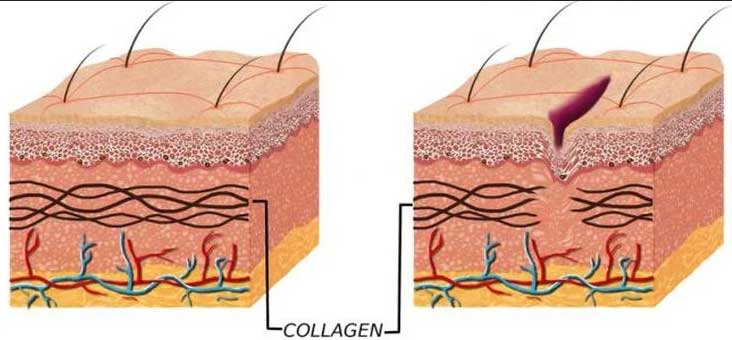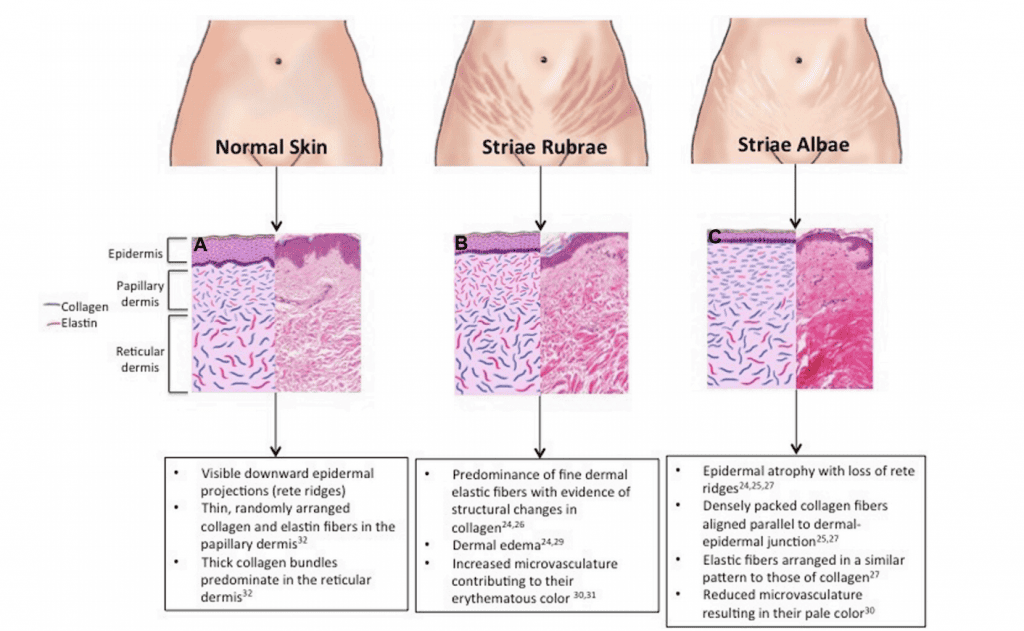Stretch marks after pregnancy are something almost every mom experiences—but not everyone wants to keep them forever. They’re often called “tiger stripes,” and while they symbolize the strength of motherhood, they can also be a source of discomfort or insecurity for many women. It’s perfectly okay to love your body and still want to care for it in ways that make you feel your best.
In Pakistan, this conversation is often swept under the rug. We don’t really talk about stretch marks, even though they affect over 90% of women after pregnancy, according to dermatological studies. You might notice them on your belly, hips, thighs, or even breasts—thin, streaky lines that start off red or purple and eventually turn silvery or white. They’re completely natural, yet for many new moms, they come as an emotional shock. Especially when you’re already dealing with hormonal changes, sleepless nights, and a body that’s recovering from childbirth.

Here’s the good news: while stretch marks can’t disappear completely, natural scar treatments can actually work to fade their appearance and improve your skin’s texture and tone. And you don’t need expensive salon procedures or painful peels. With the right knowledge, some commitment, and ingredients already found in nature, you can gently treat your skin at home.
What Causes Stretch Marks After Pregnancy? The Science Behind the Stripes
Stretch marks, or striae distensae if you want to get technical, are a type of scar that forms when the skin stretches too quickly. Think of your skin like a rubber band—it’s elastic and can stretch, but if you pull it too far, too fast, it can tear slightly. These tiny tears happen in the dermis, the middle layer of the skin, where collagen and elastin are supposed to keep things tight and bouncy. When the skin can’t keep up with the sudden growth, those support structures break down, and that’s when stretch marks form.
During pregnancy, your body is going through intense physical changes. The belly expands rapidly to accommodate the growing baby, and at the same time, hormones like cortisol and estrogen increase in the bloodstream. Cortisol, especially, can weaken the collagen in your skin, making it more vulnerable to tearing. Estrogen affects skin hydration and elasticity. Combined, these hormones create the perfect storm for stretch marks to show up.

And it's not just the belly. Many women notice stretch marks on their breasts, thighs, hips, and even their lower back, depending on how their body carries weight. These areas are all under pressure as your body adapts to new weight distribution, increased blood flow, and hormonal surges.
Let’s not forget genetics. If your mother or sister developed stretch marks during pregnancy, chances are you will too. Skin type also matters—fair or thinner skin tends to show stretch marks more clearly, while darker or more elastic skin may mask them a bit better but isn’t immune.
In Pakistan, where many women already deal with nutritional deficiencies and limited access to tailored skincare, the problem is even more noticeable. A lack of proper hydration, low protein intake, and reduced collagen production due to lifestyle or diet can all make the skin more prone to damage during pregnancy. That’s why understanding the root cause is so important if you truly want to remove pregnancy stretch marks—you have to treat from within and without.
Are They Permanent? What Science Says About Scar Fading
One of the biggest questions new moms ask is: “Will my stretch marks ever go away?” The short answer is: not completely, but they can definitely become much less noticeable.
Stretch marks go through stages. Right after they form, they often appear red, pink, or purple. This is known as the inflammatory phase, and it’s actually the best time to start treating them. The skin is still actively healing, and natural treatments can help reduce inflammation and boost collagen production. With time, they fade into a silvery-white or gray color, which is called the mature phase. At this point, they’re harder to treat, but not impossible.
According to dermatology studies, consistent topical treatment over a period of 12 to 16 weeks can significantly improve stretch mark appearance, especially if the treatments target collagen stimulation and skin hydration. The skin naturally renews itself every 28 to 40 days, but collagen production takes longer to ramp up. That’s why patience and regular care are key.
For Pakistani women, it's important to know that environmental factors—like harsh sun exposure, dehydration, and even daily habits like tight clothing or skipping moisturizers—can slow down this healing process. But the good news is, our traditional desi remedies often include natural ingredients rich in vitamins A, C, and E—all of which are excellent for supporting skin regeneration.
So no, stretch marks aren’t permanent scars that you’re stuck with forever. But they do require intentional, long-term care, especially if you’re aiming for visible fading and smoother skin.
Natural Ways to Fade Stretch Marks at Home
If you’re hoping for a miracle overnight cure, we’re sorry to say—it doesn’t exist. But that doesn’t mean you can’t make serious progress with natural scar treatments at home, using ingredients that are gentle, effective, and often already in your kitchen.
Let’s start with aloe vera—a superstar for soothing damaged skin. It hydrates, cools, and promotes healing, making it perfect for new stretch marks. You can apply pure aloe vera gel directly from the leaf or use a natural product that contains it as a main ingredient.

Rosehip oil is another powerful tool in your skin-repair kit. It’s rich in vitamin A (retinoids), which is known to help fade scars and boost collagen. Unlike synthetic retinol, rosehip is much gentler and safer for postpartum use. Just a few drops massaged into the skin daily can show results over time.
Vitamin E, whether in capsule or oil form, is excellent for improving skin texture and elasticity. It works especially well when combined with carrier oils like almond or coconut oil, which help lock in moisture and improve absorption.
Your diet plays a role too. Eating collagen-rich foods like bone broth, fish, and eggs, along with vitamin C sources like oranges, amla, or guava, can help your skin heal from within. Remember: good skin starts in the kitchen.
Now let’s talk technique. Gentle exfoliation with a soft scrub (like sugar and honey) removes dead skin cells and helps new ones surface faster. This allows oils and creams to absorb more effectively. Daily hydration is a must—dry skin won’t heal well. And consistent massage, especially after a warm shower, can boost blood circulation and encourage skin regeneration.
Why Moisture Matters: The Key to Healing Stretch-Prone Skin
When it comes to reducing stretch marks after pregnancy, moisture is everything. Think of your skin like a balloon—if it’s dry, it cracks more easily. But if it’s well-hydrated, it stretches, bends, and bounces back more smoothly. Moisturized skin is more elastic, meaning it can expand during pregnancy without tearing as much—and after birth, it heals faster too.
Dry skin heals slower because it lacks the flexibility and water content needed for regeneration. This is especially important for postpartum skin, which is going through rapid hormonal changes and needs extra support. In fact, dermatological studies show that hydrated skin produces stronger collagen—the protein that keeps skin firm and prevents scarring.

Now, not all moisturizers are created equal. If you’re trying to fade stretch marks or prevent them from deepening, you need ingredients that don’t just sit on the surface but actually nourish the skin deeply. Some of the best ingredients to look for include:
-
Shea butter – a rich, fatty substance that softens skin, promotes healing, and protects the skin barrier.
-
Cocoa butter – loaded with antioxidants and deeply hydrating, it’s been used for years in pregnancy care.
-
Centella asiatica (also called gotu kola) – a natural herb known for stimulating collagen production and improving skin texture.
-
Hyaluronic acid – a water-binding molecule that keeps the skin plump and hydrated, essential for healing.
This is exactly why our Stretch Marks & Scar Belly Balm was created—to deliver all these ingredients in one safe, effective, and luxuriously smooth formula. It’s made with the needs of real moms in mind, blending traditional care with modern science. Whether you’re just starting your stretch mark journey or looking for a product that actually works, this balm is a gentle and powerful way to support your skin’s healing process.
So if you’re searching for the best stretch mark cream in Pakistan that’s both natural and effective, start with something that truly understands postpartum skin—and respects it.
What Makes Our Belly Balm Different? (Soft Product Plug)
There are hundreds of creams on the market that claim to fade stretch marks—but not all of them are designed with real postpartum needs in mind. Many are filled with synthetic fragrances, heavy oils that clog pores, or harsh chemicals that irritate sensitive skin.
Our Stretch Marks & Scar Belly Balm stands out because it was made with input from real moms, tested on postpartum skin, and formulated with ingredients that are both gentle and effective. It’s free from parabens, sulfates, and artificial fillers, which means no weird side effects—just smooth, nourished skin that feels supported, not overwhelmed.
It’s packed with shea butter for deep moisturization, vitamin E to improve skin elasticity, and a blend of natural oils that nourish the skin barrier and support regeneration. Plus, it absorbs quickly, without leaving you feeling greasy or sticky—which is a big plus when you’re trying to juggle a baby, a home, and a thousand other things.
So if you’re tired of products that overpromise and underdeliver, and you’re looking for the best stretch mark cream in Pakistan that actually respects your body’s healing process, this balm might just be your new postpartum hero.
Myths About Stretch Marks That Need to Go
Let’s clear up a few things—because stretch marks are already frustrating enough without all the myths surrounding them.
One of the biggest misconceptions is that only thin people don’t get stretch marks. The truth? Body size has nothing to do with it. Even the fittest, healthiest women can get stretch marks during pregnancy. It’s about how fast your skin stretches, not how big you are.
Another myth is that once stretch marks appear, there’s nothing you can do. While it’s true they won’t vanish completely, it’s absolutely possible to reduce their appearance and support healthier skin with the right treatment—especially when you start early.
And let’s not forget the classic: “If you just use cream during pregnancy, you won’t get any marks.” While moisturizers help with skin elasticity, no cream can guarantee complete prevention. Stretch marks are also tied to hormones, genetics, and how fast your body grows. So no, it’s not your fault if you have them—and yes, there are real solutions that can help fade them.
The bottom line? Stretch marks are normal. What you choose to do about them is up to you—but don’t let old myths stop you from feeling confident in your skin or investing in your healing.
Realistic Expectations: Healing Skin Takes Time
If you’ve been staring at your belly, hoping your skin will bounce back in a week—take a deep breath. Healing takes time. Your body spent nine months creating life—it deserves more than a few days to repair itself.

Feeling frustrated is natural, especially when you're bombarded with "bounce back" culture on social media. But real skin healing doesn’t happen overnight. It takes weeks of daily care, patience, and kindness to yourself. The important thing is to notice the small wins—softer skin, lighter marks, more confidence when you look in the mirror.
Many moms in our community have shared their stories. For some, progress began in just a few weeks. For others, it took a few months. But across the board, they say the same thing: staying consistent made all the difference.
If you’re ready to start your own journey toward smoother, stronger skin, give yourself the grace to do it slowly, gently, and with love. And remember—you don’t have to go it alone. We’re with you, one balm rub at a time.



